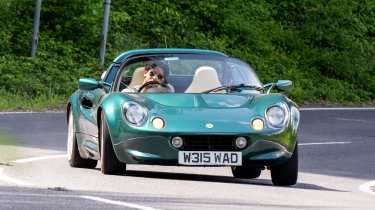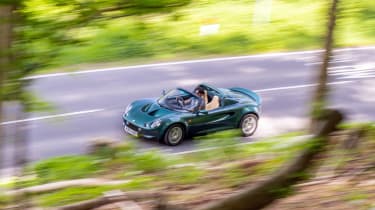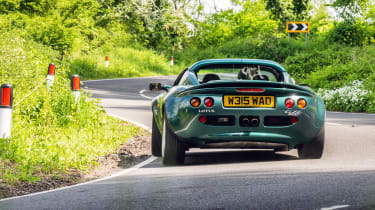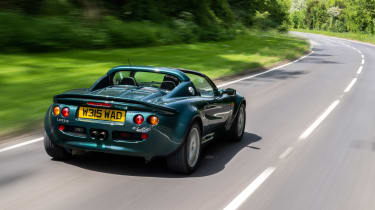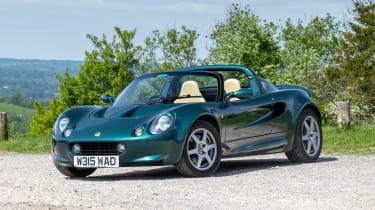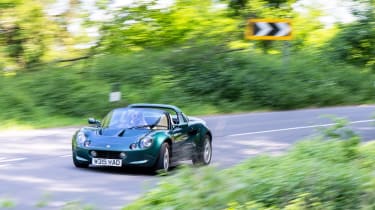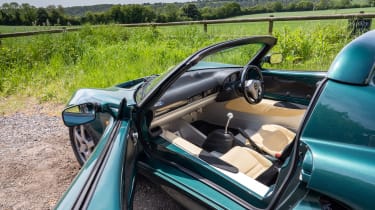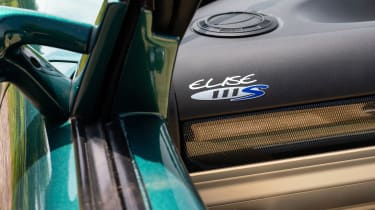Used Lotus Elise (S1, 1996-2001) review – a world-beating sports car for supermini money
Part aluminium, part composite and built on a shoestring, the Elise swept enthusiasts off their feet in 1996. Today, it remains one of the world's greatest sports cars.
The first hundred metres down the road in an Elise is rather like hearing the opening bars of a favourite song on the radio; it’s hardly begun but already you know you’re going to be entertained. Sure, the intro is a bit wobbly (think the opening chords of The Smiths’ ‘How Soon Is Now?’) because the steering is disconcertingly light and the floorpan clatters noisily over bumps, but you know that once it hits its stride you’re going to be right into it.
When the Elise appeared in 1996 it seemed almost to have come out of nowhere. Three years earlier, GM had sold Lotus to Italian businessman Romano Artioli. It’s unclear why Artioli acquired Lotus for £30million at a time when his gloriously ambitious resurrection of Bugatti with the EB110 was taking him to bankruptcy at 213mph, but he gave Lotus just what it needed – the freedom to build an all- new sports car. The small, affordable and truly innovative Elise was the result and Lotus is still enjoying the benefits today.
Steered by Lotus’s guiding principles of light weight and simplicity, the best minds at Hethel concluded that the chassis of the new car should be formed from extruded aluminium sections. Welding was a possibility but aluminium is tricky stuff and thicker sections are needed at weld points. But not if you glue the sections together. Danish company Hydro Aluminium had been working on adhesive bonding, which is also neater and more consistent than welding, and Lotus worked with them to develop the process for its first automotive application.
More reviews
Group tests
Reviews
The bare chassis, minus roll hoop, suspension arms and aluminium brakes (more on them later), weighed just 67kg. For reference, Lotus reckons the carbon tub of the Alfa 4C weighs 65kg – so much for progress. Every new Lotus since the Elise has used a form of that chassis, including even the Corvette ZR1-engined GT1 Elise racer, and if back in 2001 you’d got a close look at the aluminium chassis underpinning the new Aston Martin Vanquish you’d have seen Lotus’s fingerprints all over it.
Mid-mounted beneath the rear deck of the Elise was the ideal engine: the compact and lightweight, all-aluminium Rover K-series. Lotus selected the 1.8-litre version of the British-built, 16-valve ‘four’, producing a modest 118bhp. However, because the Elise weighed in at just 731kg, the multiplication effect of its sub-ton kerb weight gave it 164bhp per ton. That’s about the same as a contemporary Z3 2.8, so still modest, but the gutsy little K-series proved the perfect match for the Elise’s mass and grip, helping create a deliciously well rounded and satisfying car.
Despite being so avant-garde at its core, the Elise was given a retro look by Julian Thomson, with fared-in headlamps and lots of curves, perhaps to distance it from the wedgy Elan M100 that preceded it. That car, which was famously front-wheel drive, had never really hit the spot. Some reckoned it was a good car in a bad market, restricted from reaching its full potential by the early ’90s recession. But, like many potential Elan customers, I didn’t buy that. It was impressively competent but you had to go hunting for the magic, whereas the Elise gave it up freely, at ordinary speeds, to anyone who took the wheel.
Up close with the Elise again, I’m reminded that achieving a kerb weight of 731kg meant interrogating every part, hence the wind-up windows, no internal adjusters for the door mirrors, basic slider heater controls and very little interior trim: just a square foot of mat each side, a coin tray at either end of the dashboard and a pad the size of a geography teacher’s elbow patch on each sill. That’s it. There’s a little bit of genius in the exterior ‘door handle’, which is just a small plastic ridge hidden under the overhang that your fingers naturally find when you push the lock button.
Caterham Seven-style cars are even lighter, but part of the broader appeal of the Elise is that it has real doors, with glass that goes up and down. And don’t underestimate the reassurance you get from the deep-sided aluminium tub when you’ve slipped down into the shell-like seat (which looks painted-on but is surprisingly comfy and accommodating). The downside is that, with the roof in place, you have to struggle in through a narrow slot. Perhaps it’s no surprise that in the early concept stage of the Elise it was what Lotus calls a ‘stepper’, that’s to say a car without roof or doors that you step into, like a bath. Explains where the 340R came from, doesn’t it?
Once you’re settled, the dynamic initiation can begin. How light is that unassisted steering? Well, if you’ve ever sat in your car with the front wheels jacked off the ground and twirled the wheel, that’s pretty much the Elise’s steering at town speeds. And that’s with wider Yokohamas. In the wet, with so little resistance to work against, you have no sense when the front tyres are slipping wide. And that’s not all to watch out for when it’s raining...
Aluminium brakes sound right up there with chocolate fireguards, but the car’s low mass allowed the use of an innovative technology. The Elise’s Metal Matrix Composite (MMC) discs were made from aluminium with 30 per cent silicon carbide and it was estimated that they would last up to 100,000 road miles. They haven’t been available for years and it’s increasingly rare to see them; they go for about £200 a disc, so some owners have them stashed in the loft.
Back in the ’90s it was feared that, rather like carbon discs, they could be destroyed by severe overheating, and some owners swapped them, foregoing the very real benefits of lower unsprung mass at each corner to wheel control, and a lovely short pedal, too. But because they use a different principle to regular disc brakes – adherent friction instead of abrasive friction – the first application in the wet can be worryingly unresponsive. Again, not unlike early carbon brakes.
No such worries today, with the spring sun beating down and the south coast calling. Clear of town, the Elise starts to get into its stride and turn on the charm. The clatter you hear over sharp bumps and ridges is a common Elise characteristic but you soon learn to ignore it, realising that the ride is in fact remarkably supple and unusually fluid. The stiff aluminium platform and light brakes allow this comfort and control, this remarkable ride quality that is the original Elise’s outstanding, defining dynamic characteristic. You fear no road surface, relishing the challenges the surface throws at the car, guiding it with confidence onto precisely the line you want.
Greater pace transforms the steering. You find yourself carrying speed and committing confidently to turns and then it dawns on you that the tiny Nardi wheel is suffused with feel, changes of weight revealing the level of grip. The car feels four-square, planted, balanced – you can hustle it, but it’s not necessary to get great cross-country pace out of it. This is the reward for low mass. It’s also the reason why you rarely hanker for more urge from the K-series at your back; it’s so instantly responsive, so generously torquey that it becomes a natural part of the blend, the flow. It sounds eager, too, thanks to the sports exhaust that adds fruitiness rather than shouty volume.
The gearshift is less slick than I remember. The little wand has a snappy throw but the gate feels dry, like there are burrs on the edges of the H-pattern (aftermarket linkage bushes have been known to fix this). It’s all good if you add a bit of exaggeration, a bit of a flourish to your cross-gate shifts. A shame, though, that the brakes squeal like a fork across a plate until they’re up to temperature. They’re powerful, with superb feel and response, but it’s a bit distracting.
It will kick the tail wide if you’re keen, and do it tidily, but that’s not really its style. It’s the Elise’s deftness, its effortlessness across the ground that was unique and compelling back in 1996 and still is now. Back then, I got as many people into it as I could and it entertained and delighted them all, whether they drove or rode in it. Well, almost all. Not Jez Coates, technical director at Caterham Cars. The maker of the Seven had been looking for years to expand its range with a more habitable, lightweight sports car and in August 1996 launched the 21. A month later, Lotus launched the Elise.
It was Caterham’s worst nightmare come true. Beneath the 21’s swoopy bodywork was a Seven spaceframe with lateral extensions for side impact protection, and there was a boot and real doors, too. It drove well, like a Seven in fact, and in entry-level, 115bhp K-series trim weighed about 60kg less than the Elise. But it was more expensive. Only a bit, but enough.
Jez didn’t believe the Elise was deserving of all the praise my fellow journalists and I were heaping on it. So we went for a drive on roads with lots of tricky bumps and surfaces. His mood got darker the further we went and after one particularly challenging section of asphalt that the Elise dispatched as if it was a large rubber conveyor belt, I shouted over: ‘Impressive, isn’t it?’ The reply was a grudging grunt. The 21 wasn’t a bad car but it was doomed, and we both knew it.
Inevitably, when you make something that handles so well, even if it seems to have just the right amount of power, more potent versions come along. I can claim to be the only journalist to have driven the first of them, the 143bhp Elise Sprint, fitted with the VVC K-series. Sprint is an evocative name with authentic Lotus heritage but you’ll know the model as the 111S because at the time the use of the Sprint name was successfully contested by another brand. Think about that the next time you’re overtaken by a Mercedes Sprinter van...
Just over 10,600 S1 Elises were made before the more grown-up, better-equipped S2 took over in 2001. It’s a testimony to the concept that, almost 21 years on from launch, the original 118bhp S1 still delivers. As with other great drivers’ cars such as the E30 M3 and the original Elan, all things feel in balance – power, grip, handling and mass. Indeed, the dynamics of the Elise are so fluid that the ride and handling are the same thing. It makes for a uniquely satisfying experience – and guaranteed five-star evo icon status.
Lotus Elise S1 buying guide
Drive a sorted S1 Elise and you're probably going to want one. The key word here is 'sorted', though, because these cars are incredibly sensitive to setup and condition – with tired suspension bushes, dodgy alignment and worn dampers, the Elise can feel like a wobbly, clattery mess with volatile handling. Because of its mechanical simplicity and your intimate connection to its components, everything needs to be in good shape to conjure that Elise magic. With that in mind, it may be a good idea to hunt down a solid, honest example at the lower end of the market, leaving some budget aside for a mechanical refresh (many early Elises need this by now anyway).
Suspension and chassis
Suspension bushes, ball joints and steering rack refurbishment kits are readily available from specialists, so too are upgraded toe links (the original rear toe links have been known to fail on track, causing an immediate loss of control and a trip to the gravel trap – or worse). Working on the Elise's suspension is mostly a piece of cake, but if you don't fancy operating the spanners, a specialist will charge around £2500 to complete the job (including parts).
The Elise's supple ride is its defining dynamic attribute, and while the original Koni suspension units are hard to come by these days, aftermarket options are available to retain – and enhance – the car's character. Lotus supplied an uprated Bilstein kit in period; derived from the S2 Elise setup with mildly stiffer springs, the Bilsteins offer tighter control without eroding that trademark fluidity. Today, the kit is a popular fitment for road use and costs around £1200 plus fitting.
On a bigger budget, Nitron offers a range of high-end adjustable coilovers, starting from £1489 for its NTR 40 Fast Road kit and rising to £3425 (prices not including VAT) for three-way adjustable race dampers with larger pistons and remote canisters. We've sampled the Fast Road kit on evo's Fast Fleet Elise, and it takes the car's cornering performance to a much higher level. With significantly stiffer spring rates there's less roll and more grip to lean on, but the quality of the damping means that the ride is actually improved over certain surfaces. For those wanting more compliance, roll and throttle adjustability, Nitron can supply near OEM-spec spring rates to retain the distinctive handling traits of a standard Elise, but with the edges rounded off thanks to the more sophisticated dampers.
Rumour has it that Lotus’s chassis engineers originally specified a quicker steering rack for the S1 Elise, but a slower ratio was selected late in its development to make the car less snappy for the masses. With modern tyres and suspension, the Elise doesn't tend to bite back as it used to, and the quicker rack – available from the OE supplier Titan – feels more in tune with the car's natural agility. If the standard rack is worn (the internal nylon cups tend to go first), the quicker unit is a worthwhile upgrade.
The Elise’s strengths as a sports car stem from its innovative aluminium structure, but this can also be the source of ruinous expense. Wheel impacts in a crash can cause serious damage to the suspension mounting points, and due to the nature of the bonded construction, most specialists would advise against repair, pointing you towards a replacement chassis instead (good luck finding one of those). The wishbone mounting areas can also suffer from oxide corrosion, causing perforations in the metal in extreme cases. It's worth examining these areas very carefully before purchase.
Engine and gearbox
Much has been made of the Elise S1’s vulnerability to head gasket failure, but the K-series engine isn't necessarily a source of trouble. Most examples will have had a replacement head gasket by now, and multi-layer steel items are available with improved durability. A gentle warm-up procedure is essential to avoid thermal shock, and aftermarket pressure relief thermostat valve kits can be fitted to ensure slow, even temperature changes inside the engine and reduce the risk of head gasket failure. A fit and healthy K-series is a joyous unit, and – whisper it – better suited to the Elise's character than the Toyota engine fitted to later models.
The barebones nature of the Elise means that a flurry of mechanical sounds filter through to the cabin, and whining noises from the drivetrain are a characteristic rather than a fault. But it can be made to sound an awful lot better with aftermarket induction kits, or a sports exhaust. UK firm Janspeed supplied a sports exhaust option for the S1 in period, and today offers an upgraded 4-2-1 manifold, link pipe, sports cat and back-box in stainless steel. Combined, these elements unlock a much rortier and exciting note from the K-series without being boomy or unnecessarily loud, and performance benefits too. Engine response is made noticeably crisper, with zippier throttle blips when rev matching and more urgent acceleration. The extra edge and harder bark from the engine make every drive that bit more exciting.
The five-speed PG1 gearbox uses standard or shortened ratios depending on the model, and while the shift is notchy and vague from factory, upgraded linkage kits dramatically improve the feel. You can go the extra mile with an uprated shifter mechanism – such as Prodimex’s billet aluminium item – to provide a slicker, more positive action across the gate and into gears, too.
Bodywork and interior
Julian Thomson was inspired by his own Ferrari 246 Dino when designing the Elise, and the flowing curves and cowled headlights are pure ’60s sports car. However, the body panels are made from glassfibre and can be tricky to repair to a high standard, so scan for any surface cracks or bubbling in the paintwork. Serious damage can necessitate replacing the clamshells, which cost around £1600 and £2000 for the front and rear respectively.
The Elise’s interior is about as simple as it gets – the tiny Nardi steering wheel is completely uncluttered, the dashboard is made up of extruded aluminium sections and the seats are basic solid-shell items. The pedals, perfectly placed and made from pieces of extruded aluminium, are a particular highlight. There isn’t much to go wrong here, although it’s worth peeking underneath the carpet for signs of aluminium corrosion on the floor pans. Some models left the factory with rubber mats glued to the floor, and these can trap moisture and cause pitting in the aluminium. DIY repairs are possible using epoxy metal filler and corrosion-resistant paint.
What to pay
For an unmodified S1 Elise with more than 50,000 miles under its belt, expect to pay around £15,000, with low-mileage time-warp examples costing upwards of £21,000. More powerful variants of the Elise emerged throughout its life, and one of our favourites is the Sport 135.
Thanks to a reworked cylinder head it offered (you guessed it) 135bhp, and it was initially launched as a limited run of 50 cars, all painted Quicksilver and equipped with headlight covers, driving lights, red sports seats and a red steering wheel. Drilled brake discs were also included, along with a close-ratio gearbox and a sports exhaust without a catalytic converter. A further 35 Sport 135s were produced in 1999, and given its rarity, you’ll pay at least a few grand more than for an equivalent standard Elise.
More widely available is the 111S – the sweet spot for usability and performance, with prices starting from £18000. The 111S gained variable valve control (VVC) and 143bhp, which combined with a close-ratio gearbox cut the 0-62mph time down to 5.4sec from the standard car’s 5.9. It also had OZ Racing six-spoke wheels (up half an inch in width at the rear to 7.5 inches), a new front grille, headlamp covers, a composite engine cover and a raised rear spoiler. Extra padding in the seats raises the driving position slightly but does wonders for long-distance comfort.
The last of the production-spec variants, the Sport 160, arrived in February 2000. The first 50 were produced with Single Vehicle Approval and featured a 160bhp engine; later cars passed Whole Vehicle Type Approval and had to make do with 150bhp, although many of these cars were upgraded after purchase. The 160 was loosely based on the 111S but had a new ECU, revised suspension, different wheels and a plinth-mounted rear spoiler. Well-maintained Sport 160s cost from £24,000.
‘I bought one’
Yousuf Ashraf, evo Senior staff writer
‘My journey to Elise ownership began in 2021, when I drove an early S1 for the first time. I was hooked from the first few corners, baffled at the Elise’s ability to take broken B-roads in its stride and dance to your tune at the limit. It was the best car I’d ever driven at the time, and with values threatening to rise, I secured my own example a few months later – a well-used but highly original metallic green 111S.
‘After my first 1000 miles in the car, I made some careful changes to enhance the bits that I loved, and fix what I thought could be better. New Bilstein dampers from the S2 Elise replaced the original Konis, a quicker steering rack went in, all the suspension bushes were renewed and I fitted a set of gorgeous aluminium-belled brake discs with braided lines.
‘Now my Elise is spellbinding. It boils down to how it pulls you into the experience on any road, at any speed – I’ve done 8000 miles in it so far and I’ve never had a boring journey. At a cruise it just floats along and chatters away in your hands, but when the time is right, it tenses up and demands absolute focus at the limit. I’ve never driven anything quite like it – mine will stick around for a very long time.’
Lotus Elise S1 specs
| Lotus Elise | Lotus Elise Sport 160 | |
| Engine | In-line 4-cyl, 1796cc | In-line 4-cyl, 1796cc |
| Max power | 118bhp @ 5500rpm | 160bhp @ 7000rpm |
| Max torque | 122lb ft @ 3000rpm | 128lb ft @ 5200rpm |
| Weight | 731kg | 770kg |
| Power-to-weight | 164bhp/ton | 211bhp/ton |
| 0-60mph | 6.1sec (tested) | 5.1sec (claimed) |
| Top speed | 126mph (claimed) | 135mph (claimed) |
| On sale | 1996 | 2000 |
| Price new | £18,950 (1996) | £28,995 (2000) |
